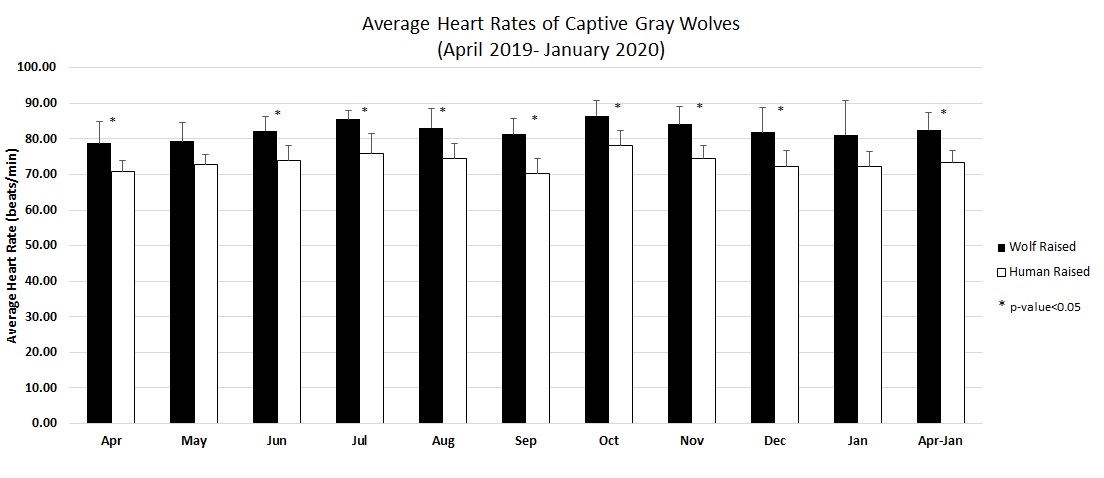Background: In order to characterize the impact of environmental factors on a species, both methods for collecting such information and baseline values are required. Advances in implantable cardiac monitors for human patients provide an opportunity for sophisticated physiologic monitoring in wild species. This study aimed to collect baseline data on cohorts of captive gray wolves housed at the Wildlife Science Center in Stacy, MN. Twelve wolves in four cohorts of wolves were included in this study. Three wolves were wild-born/wolf-raised, three were captive-born/wolf-raised, and two cohorts of three wolves were captive-born/human-raised. Methods: To collect physiological data, insertable cardiac monitors (ICM; Medtronic Reveal LINQTM) with custom software (B-Ware) were subcutaneously implanted in a left axillary position in 12 sub-adult wolves. The ICM has a 3-year life and records average heart rates (HR) over 2-minute intervals, activity in 15-minute intervals, and subcutaneous impedance, temperature, and posture once every 4 hours. Following implantation, the wolves were handled at least once per year and data downloads were conducted wirelessly (Medtronic CareLinkTM programmer). Results: Several months of high-density physiological data were successfully retrieved from 10 wolves for inclusion in this analysis. Monthly average HR was calculated for each wolf based on two-minute averages (at least 188,026 HR values were available and analyzed per animal). Two-tailed t-tests were performed to determine differences in heart rates among the cohorts. When comparing wolf-raised versus human-raised, it was found that the wolf-raised cohorts had significantly higher HRs overall (82.5 versus 73.4 bpm) and differences were significant in 8 of 10 months (p<0.05). The two animals with the highest average heart rates were both wild-born/wolf-raised (87.7 and 87.8 bpm). Four of the five animals exhibiting the lowest heart rates were captive-born and human-raised. See bar graph for details. Additional analyses are in progress, including daily and monthly variations in HR, in addition to an assessment of the other physiological parameters. Conclusions: Insertable cardiac monitors were successfully deployed in captive gray wolves, capturing long term physiological recordings. Heart rates were characterized in a population of wolves, including wild-/captive-born, and wolf-/human-raised. These methods and results can provide a foundation for future studies on the impact of climate change and/or human interactions on wolf welfare and behavior.
Future Physiology 2020 (Virutal) (2020) Proc Physiol Soc 46, OC13
Oral Communications: Establishing Baseline Physiological Parameters in the Gray Wolf (Canis lupus) for Future Environmental Impact Studies
Noelle Laske1, Roberta Ryan2, Mark Beckel2, Rosana Moraes3, Timothy Laske4, Peggy Callahan2
1 University of St. Thomas, St. Paul, MN, The United States of America 2 Wildlife Science Center, Stacy, MN, The United States of America 3 Smithsonian Conservation Biology Institute, Front Royal, VA, The United States of America 4 University of Minnesota, Minneapolis, MN, The United States of America
View other abstracts by:
Where applicable, experiments conform with Society ethical requirements.

